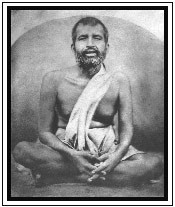
COMPOSER Ramakrishna Paramahamsa |
|
|||||||||||||
|
Ramakrishna Parmahamsa is perhaps the best known saint of nineteenth century India. He was born in a poor Brahman family in 1836, in a small town near Calcutta, West Bengal. As a young man, he was artistic and a popular storyteller and actor. His parents were religious, and prone to visions and spiritual dreams. Ramakrishna's father had a vision of the god Gadadhara (Vishnu) while on a religious pilgrimage. In the vision, the god told him that he would be born into the family as a son. Young Ramakrishna was prone to experiences of spiritual reverie and temporary loss of consciousness. His early spiritual experiences included going into a state of rapture while watching the flight of a cranes, and loosing consciousness of the outer world while playing the role of the god Shiva in a school play. Ramakrishna had little interest in school or practical things of the world. In 1866, he became a priest at a recently dedicated temple to the Goddess Kali located near Calcutta on the Ganges River. It was built by a pious widow, Rani Rasmani. Ramakrishna became a full-time devotee to the goddess spending increasing amounts of time giving offerings and meditating on her. He meditated in a sacred grove of five trees on the edge of the temple grounds seeking a vision of the goddess Kali. At one point he became frustrated, feeling he could not live any longer without seeing Kali. He demanded that the goddess appear to him. He threatened to take his own life with a ritual dagger (normally held in the hand of the Kali statue). At this point, he explained how the goddess appeared to him as an ocean of light: When I jumped up like a madman and seized [a sword], suddenly the blessed Mother revealed herself. The buildings with their different parts, the temple, and everything vanished from my sight, leaving no trace whatsoever, and in their stead I saw a limitless, infinite, effulgent Ocean of Consciousness. As far as the eye could see, the shining billows were madly rushing at me from all sides with a terrific noise, to swallow me up. I was caught in the rush and collapsed, unconscious … within me there was a steady flow of undiluted bliss, altogether new, and I felt the presence of the Divine Mother. Mahendranath Gupta, Ramakrsna Kathamrta translated by Swami Nikhilananda as The Gospel of Sri Ramakrishna (Mylapore: Sri Ramakrsna Math, 1952), Book 1, p. 15 Ramakrishna's behavior became more erratic as time passed and began to worry his family and employer. He would take on ritual and mythical roles identifying with figures from the Puranas (medieval Indian holy books describing the adventures of gods). His parents found him a wife hoping his mental instability was a result of his celibacy. About this time, an elderly holy woman named Bhairavi Brahmani appeared and determined that Ramakrishna's madness was "spiritual madness" rather than ordinary madness. He was literally mad for the vision of God. She convened a group of respected religious leaders who examined Ramakrishna's symptoms. They concluded that this was a case of divine madness similar in nature to that of other famous saints such as Caitanya (a fifteenth century Bengali saint). From this point on, people began to treat Ramakrishna with more respect though his unusual behavior in worship and meditation continued. The holy women stayed with Ramakrishna for some time teaching him yogic and tantric meditation techniques. A yogin named Totapuri then became Ramakrishna's mentor. Ramakrishna adopted the role of renunciant and learned a nondualist form of Vedanta philosophy from him. In this system, God is understood to be the formless unmanifest energy that supports the cosmos. Ramakrishna experienced a deep form of trance (nirvilkalpa samadhi) under the guidance of this teacher. This state can be described as complete absorption of the soul into the divine ocean of consciousness. Disciples began to appear at this point in Ramakrishna's life. He embarked on a long period of teaching where he gathered a group of disciples around him. This period of his life is well documented by two sets of books written by his disciples. These references are listed below. Ramakrishna explained on different occasions that god is both formed and formless and can appear to the devotee either way. He often asked visitors whether they conceived of god as having qualities or as being beyond qualities. He then proceeded to teach the devotee according to the way he or she viewed the divine. His acceptance of different approaches to the worship of God and the validity of different religious paths, such as Christianity and Islam, is in the best tradition of the universalist approach to religion common throughout India today. Ramakrishna died of cancer of the throat in 1886.
|
||||||||||||||




